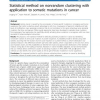Free Online Productivity Tools
i2Speak
i2Symbol
i2OCR
iTex2Img
iWeb2Print
iWeb2Shot
i2Type
iPdf2Split
iPdf2Merge
i2Bopomofo
i2Arabic
i2Style
i2Image
i2PDF
iLatex2Rtf
Sci2ools
BMCBI
2010
2010
Statistical method on nonrandom clustering with application to somatic mutations in cancer
Background: Human cancer is caused by the accumulation of tumor-specific mutations in oncogenes and tumor suppressors that confer a selective growth advantage to cells. As a consequence of genomic instability and high levels of proliferation, many passenger mutations that do not contribute to the cancer phenotype arise alongside mutations that drive oncogenesis. While several approaches have been developed to separate driver mutations from passengers, few approaches can specifically identify activating driver mutations in oncogenes, which are more amenable for pharmacological intervention. Results: We propose a new statistical method for detecting activating mutations in cancer by identifying nonrandom clusters of amino acid mutations in protein sequences. A probability model is derived using order statistics assuming that the location of amino acid mutations on a protein follows a uniform distribution. Our statistical measure is the differences between pair-wise order statistics, whi...
| Added | 08 Dec 2010 |
| Updated | 08 Dec 2010 |
| Type | Journal |
| Year | 2010 |
| Where | BMCBI |
| Authors | Jingjing Ye, Adam Pavlícek, Elizabeth A. Lunney, Paul A. Rejto, Chi-Hse Teng |
Comments (0)

